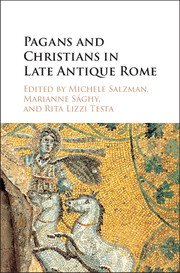 Pagans and Christians in Late Antique Rome
Pagans and Christians in Late Antique Rome Book contents
- Frontmatter
- Contents
- List of Illustrations
- Biographies of Authors
- Acknowledgments
- Introduction
- Part I SENATORIAL POLITICS AND RELIGIOUS CONFLICT
- Part II The Construction of New Religious Identities
- Part III Pagans and Christians: Coexistence and Competition
- Section A Pagans and Religious Practices in Christian Rome
- Section B Death and the Afterlife
- Section C Reading Religious Iconography as Evidence for Pagan–Christian Relations
- 16 Rome and Imagery in Late Antiquity: Perception and Use of Statues
- 17 What to Do with Sacra Antiqua? A Reinterpretation of the Sculptures from S. Martino ai Monti in Rome
- 18 Myth and Salvation in the Fourth Century: Representations of Hercules in Christian Contexts
- Concluding Remarks: Vrbs Roma between Pagans and Christians
- Index
- References
17 - What to Do with Sacra Antiqua? A Reinterpretation of the Sculptures from S. Martino ai Monti in Rome
from Section C - Reading Religious Iconography as Evidence for Pagan–Christian Relations
Published online by Cambridge University Press: 05 November 2015
- Frontmatter
- Contents
- List of Illustrations
- Biographies of Authors
- Acknowledgments
- Introduction
- Part I SENATORIAL POLITICS AND RELIGIOUS CONFLICT
- Part II The Construction of New Religious Identities
- Part III Pagans and Christians: Coexistence and Competition
- Section A Pagans and Religious Practices in Christian Rome
- Section B Death and the Afterlife
- Section C Reading Religious Iconography as Evidence for Pagan–Christian Relations
- 16 Rome and Imagery in Late Antiquity: Perception and Use of Statues
- 17 What to Do with Sacra Antiqua? A Reinterpretation of the Sculptures from S. Martino ai Monti in Rome
- 18 Myth and Salvation in the Fourth Century: Representations of Hercules in Christian Contexts
- Concluding Remarks: Vrbs Roma between Pagans and Christians
- Index
- References
Summary
One of the most important aspects of late antique paganism is the shifting involvement of the state and imperial courts in public religion. The elimination of state subsidies and evanescent imperial interest in the traditional public cults had a profound impact on the sacred landscape. The present chapter focuses on one such change, privatization of previously public cults, and in particular whether this phenomenon can be archaeologically observed in Rome. After a brief discussion of privatization in the sacred landscape, I will discuss the case of the Iseum from the Church of S. Martino ai Monti in Rome.
For the Romans, public religion was part of the complex system of government and delegated to the same people who actually ran the state. This rule was the norm both in theory and in practice until late antiquity. What happened when the state was actually no longer interested in performing its religious duties? At first view, this would lead to a cessation of cultic rites performed pro populo Romano. According to the traditional definition of Festus, public cults had to be financed from public funds, performed on behalf of the people and in a space consecrated publicly according to the customs and traditions of the state. The lack of state involvement involved at least the lack of public funding of state officials who would supervise the rites and, at least in the light of imperial legislation, the lack of suitable public spaces. Yet in practice several attempts were made to fill the gap left by the state. They all shared the desire to replace the void, or at least part of it, through private actions. They can be seen as a process of privatization of public religion. Behind this general common goal, the solutions found were diverse, and this diversity is the key to understanding changes in the late antique pagan landscape. Individuals and groups interested in pagan cults adopted their own solutions and reacted to particular circumstances. Symmachus writes in one case that the “religious authorities” have decided to convey the cult of the gods, “for a public homage” to the citizens. This decision can only be understood if one considers the particular role and function of Roman magistracies. In the Greek East, where priesthoods were often not specialized, leading citizens took the initiative directly to perform public rites, even when not acting as magistrates.
- Type
- Chapter
- Information
- Pagans and Christians in Late Antique RomeConflict, Competition, and Coexistence in the Fourth Century, pp. 360 - 378Publisher: Cambridge University PressPrint publication year: 2015


